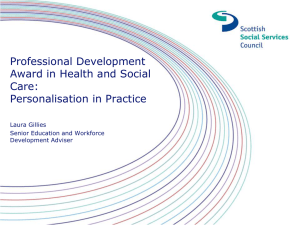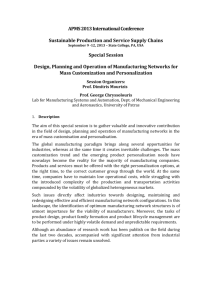Legal Principles of Personalisation
advertisement
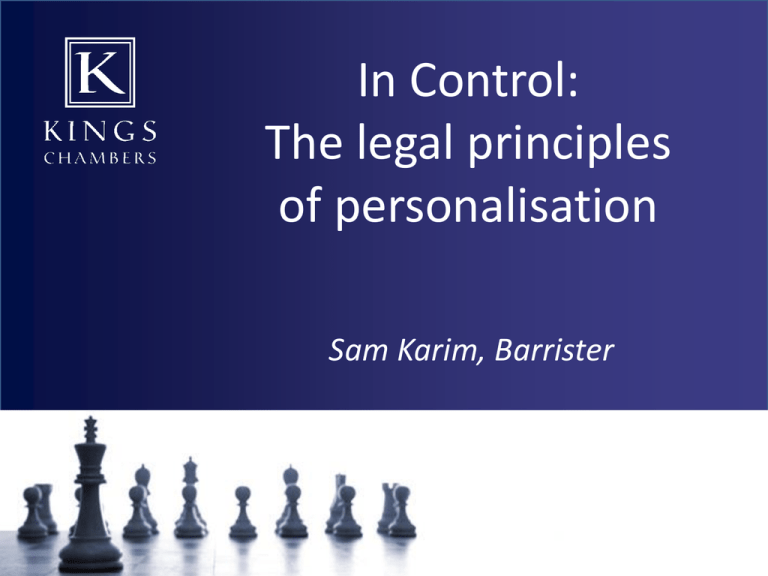
In Control: The legal principles of personalisation Sam Karim, Barrister What is personalisation? • Personalisation is defined broadly by government as ‘the way in which services are tailored to the needs and preferences of citizens. The overall vision is that the state should empower citizens to shape their own lives and the services they receive’ (HM Government Policy Review, 2007: p. 7). • The Local Government Circular (2008) ‘Transforming Social Care’. Paragraphs 21 and 26 of the Circular provide: • ‘... The purpose of this reform is to ensure people have choice and control over the support they need to live the lives they want. It is necessary to tackle all four together to deliver the Government’s aims of better health and better care for people who need treatment and support, as well as better value for taxpayers.’ Why the change? • Traditional modes of social delivery have been argued to produce the dependency of individuals, rather than promoting independence (Morris, 2006). • Leadbeater (2004: pp 18-19) suggests that: • personalisation is ‘a new organising logic for service provision…as influential as privatisation was in the 1980s and 1990s in reshaping service provision’; and • he argues that personalisation is ‘a very potent but highly contested idea’. He goes on to conceptualise personalisation as existing on a continuum, where there is a ‘shallow’ version at one end and (his favoured) ‘deep personalisation’ at the other. Let’s look at this: • But there are opponents: • Ferguson (2007: p. 401) argues that, ‘in its uncritical acceptance of the marketisation of social work and social care; in its neglect of issues of poverty and inequality; in its flawed conception of the people who use social work services; in its potentially stigmatising view of welfare dependence; and in its potential for promoting, rather than challenging, the deprofessonalisation of social work, the philosophy of personalisation is not one that social workers should accept uncritically’. My view • Personalisation agenda is defined by the following 4 themes: • a radical re-engineering of the provision of care services so that service users should have choice and control over the support delivered in a manner that promotes independence, well-being and dignity; • a major change of the relationship between the citizen and the state as the emphasis of self assessment with social workers acting as ‘brokers’ and ‘advocates’ rather than ‘gate keepers’ of social services; • control and choice of service to promote selfdirected support to enable individual arrangements to be designed by the service user; and • flexibility of support. Where did the phenomenon come from? 1. move towards greater self-directed support and individualised funding is an international phenomenon – with many developed countries experimenting with similar forms of what the US calls ‘consumer-directed care’ or ‘cash and counseling’ (see, for example, Alakeson, 2007;Robbins, 2006;Glasby & Littlechild, 2009); 2. at the beginning, the campaign for direct payments was seen as part of a broader struggle for greater choice, control and independent living, with disability re-defined as being the social, cultural and attitudinal barriers to disabled people participating as equal citizens, rather than in terms of individual impairment (e.g. Oliver, 1996). Note the relevant of the EA 2010 duties; 3. the Community Care (Direct Payments) Act 1996 overturned aspects of the National Assistance Act 1948 that prevented local authorities to provide cash payments to disabled people; 4. but direct payments represented a ‘qualified form of empowerment’ (p. 470, Oliver) as they do not alter the basic needs-based and meanstested basis of the English welfare system. So what about personal budgets, is it any different? • In theory it offers all the advantages of direct payments whilst also starting to transform the system as a whole with seven key steps to selfdirected support as: • step 1 – Using a resource allocation system (RAS), everyone is told their financial allocation and they decide what level of control they wish to take over their budget; • step 2 - People plan how they will use their personal budget to get the help that is best for them; • step 3 - The local authority helps to create good support plans, checks they are safe and any necessary representation; • step 4 - People control their personal budget to the extent they want; • step 5 - People can use their personal budget flexibly (including for statutory services); • step 6 - People can use their personal budget to achieve the outcomes that are important to them; and • step 7 - The authority continues to oversee the situation. Personal Budgets are one part of a new system of support Any problems with the system? • The practice of self assessment is of questionable legality – in R (B) v Cornwall CC [2009] EWHC 491 (Admin), at para [68] Hickinbottom J observed that a council could not ‘avoid its obligation to assess needs etc by failing to make an appropriate assessment themselves, in favour of simply requiring the service user himself to provide evidence of his needs’. • In R (Savva) v Kensington & Chelsea RLBC [2010] EWHC 414 (Admin) illustrates a potential problem. Facts: • 70-year-old applicant completed a SelfAssessment Questionnaire (SAQ); • it decided that this equated to a ‘points score’ of 16 under their RAS translating to value of £82.91 per week. • the council adjusted it to £132.56, and was then increased to £170.45. • she was admitted to hospital with increasing needs and completed SAQ and was awarded 28 points equating to a value of £112.21 adjusted to £142.02 then to £170.45. • It was challenged successfully on the basis that although her needs had increased substantially, her allowance remained unchanged: the judge, like the applicant could make neither head nor tail of it. Legal principles • There are three fundamental legal foundations to the concept of ‘personalisation’ and ‘independent living’, namely: • 1. The UN Convention on the Rights of Persons with Disabilities (ratified by the UK in 2009), in particular see Article 19: Living independently and being included in the community which provides that: • ‘(a)Persons with disabilities have the opportunity to choose their place of residence and where and with whom they live on an equal basis with others and are not obliged to live in a particular living arrangement; • (b) Persons with disabilities have access to a range of in-home, residential and other community support services, including personal assistance necessary to support living and inclusion in the community, and to prevent isolation or segregation from the community; • (c) Community services and facilities for the general population are available on an equal basis to persons with disabilities and are responsive to their needs.’ • 2. Equality Act 2010 (‘EA 2010”) which states: • “(1) A public authority must, in the exercise of its functions, have due regard to the need to— • (a) eliminate discrimination, harassment, victimisation and any other conduct that is prohibited by or under this Act; • (b) advance equality of opportunity between persons who share a relevant protected characteristic and persons who do not share it; • (c) foster good relations between persons who share a relevant protected characteristic and persons who do not share it. • 3. Article 8 of the ECHR considerations, in particular the case of R (A & B) v East Sussex County Council No 2 (2003) 6 CCLR 194 in which Munby J (as he then was) reinforced that the right of a disabled individual to participate in the life of the community and to have what he described as ‘access to essential economic and social activities and to an appropriate range of recreational and cultural activities’, thereby prevented isolation and being deprived of the possibility of developing a personality.

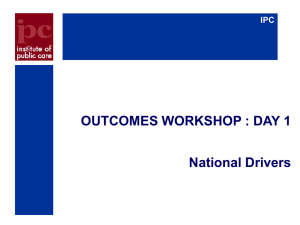
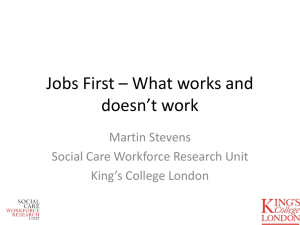
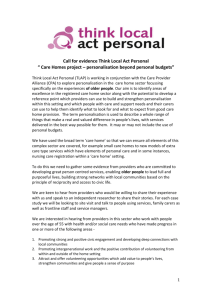

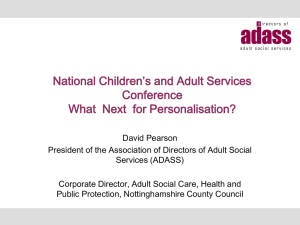
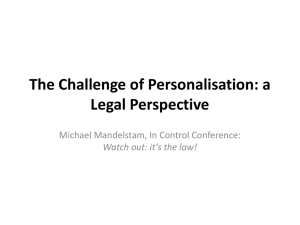
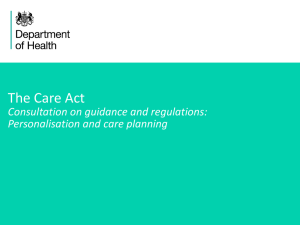
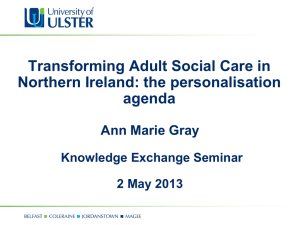
![Transformational Change [Powerpoint Presentation]](http://s2.studylib.net/store/data/005447411_1-da0a83bd34bdb90183940ab700125003-300x300.png)
